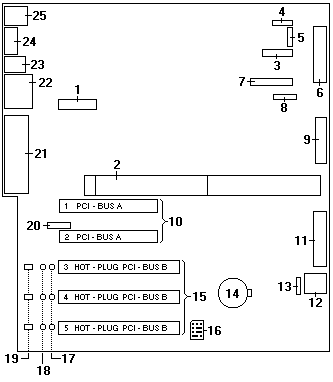Troubleshooting
Problem
Considerations when installing adapters in the system
Resolving The Problem
You can add adapters to extend the capabilities and power of the server. Many adapters provide bus-master capabilities, which enable the adapters to perform operations without interrupting the server's microprocessor. You can install up to five peripheral component interconnect (PCI) adapters in the expansion connectors, called slots, on the system board of the server.
In three of the PCI slots, you can install a new PCI adapter or replace an existing PCI adapter with the same type of adapter without turning off the server power and restarting the system, if these features are supported by the operating system. These slots are called hot-pluggable PCI slots. They are also referred to as hot-plug PCI slots. The two remaining PCI slots support standard (non-hot-plug) PCI adapters.
The server comes with a video controller. This video controller is an integrated component on the system board. It is not in an expansion slot. The integrated video controller has super video graphics array (SVGA) technology. The integrated video controller is not removable. If you want to disable this controller and use a video adapter instead, you can install a video adapter in an expansion slot. When you install a video adapter, the server BIOS automatically disables the integrated video controller.
The following illustration shows the location of the PCI expansion slots on the system board.

10 Non hot-plug 32-bit PCI slots 1 and 2 (on PCI bus A)
15 Hot-plug 64-bit PCI slots 3 to 5 (on PCI bus B)
17 Power LEDs for hot-swap slots
18 Internal attention LEDs for hot-swap slots
19 External attention LEDs for hot-swap slots
| LEDs for Hot-plug PCI Slots |
|---|
Each hot-plug PCI slot has three LEDs associated with it - two Attention LEDs and one Power LED.
Power LED
This LED is on when the hot-plug PCI slot is active and has power. An adapter must not be added to or removed from the PCI slot when the Power LED is on. When this LED is off, the PCI slot is inactive and has no power applied. An adapter can be installed when the Power LED for the PCI slot is off. Refer to the operating system documentation to determine if it supports hot-plug PCI adapters, and, if so, how to disable the hot-plug PCI slot.
Attention LEDs
Each hot-plug PCI slot has an Attention LED that is visible from the rear of the server and one that can be seen from inside the server. (The LEDs have the same meaning; they are duplicated to be visible from outside or inside the server.) An Attention LED flashes approximately once per second when it is on. The meaning of the Attention LEDs is defined by the operating system. Refer to the operating system documentation to determine if it supports hot-plug PCI adapters and, if so, what the Attention LEDs indicate.
The following table describes the LEDs:
| Power LED | Attention LED | Description |
|---|---|---|
| On | Flashing | The adapter requires attention. Slot still has power applied. Do not remove or install an adapter in the slot. Refer to the operating system documentation for instructions. |
| On | Off | Normal operation; no intervention is required. |
| Off | Flashing | The adapter requires intervention. Power is removed from the slot. An adapter can be removed or installed in the slot. |
| Off | Off | Power is removed from the slot. An adapter can be removed or installed in the slot. |
| Adapter considerations |
|---|
Before you continue with the adapter-installation procedure:
- Review the documentation that comes with the adapter and follow those instructions in addition to the instructions given in this chapter. If you need to change the switch or jumper settings on the adapter, follow the instructions that come with the adapter documentation.
- You can install full length adapters in all expansion slots.
- You can install hot-plug PCI adapters in PCI slots 3-5, if the operating system supports this feature. Non-hot-plug PCI adapters can also be installed in these slots.
- The server supports 5.0V and universal PCI adapters; it does not support 3.3 V adapters.
Note: A universal PCI adapter supports both 3.3V and 5.0V operation.
- The server uses a rotational interrupt technique to configure PCI adapters. Because of this technique, you can install a variety of PCI adapters that currently do not support sharing of PCI interrupts.
- PCI slots 1 and 2 are on PCI bus A and PCI slots 3-5 are on PCI bus B. Both PCI buses are primary buses. The system scans PCI slots 1 through 5 to assign system resources; then the system starts (boots) the PCI devices in the following order, if the default boot precedence has not been changed: PCI slots 1 and 2, system board SCSI devices, and then PCI slots 3 through 5.
Note: The performance of the PCI adapters depends on the configuration of adapters in the system.
Document Location
Worldwide
Was this topic helpful?
Document Information
Modified date:
23 January 2019
UID
ibm1MIGR-45366